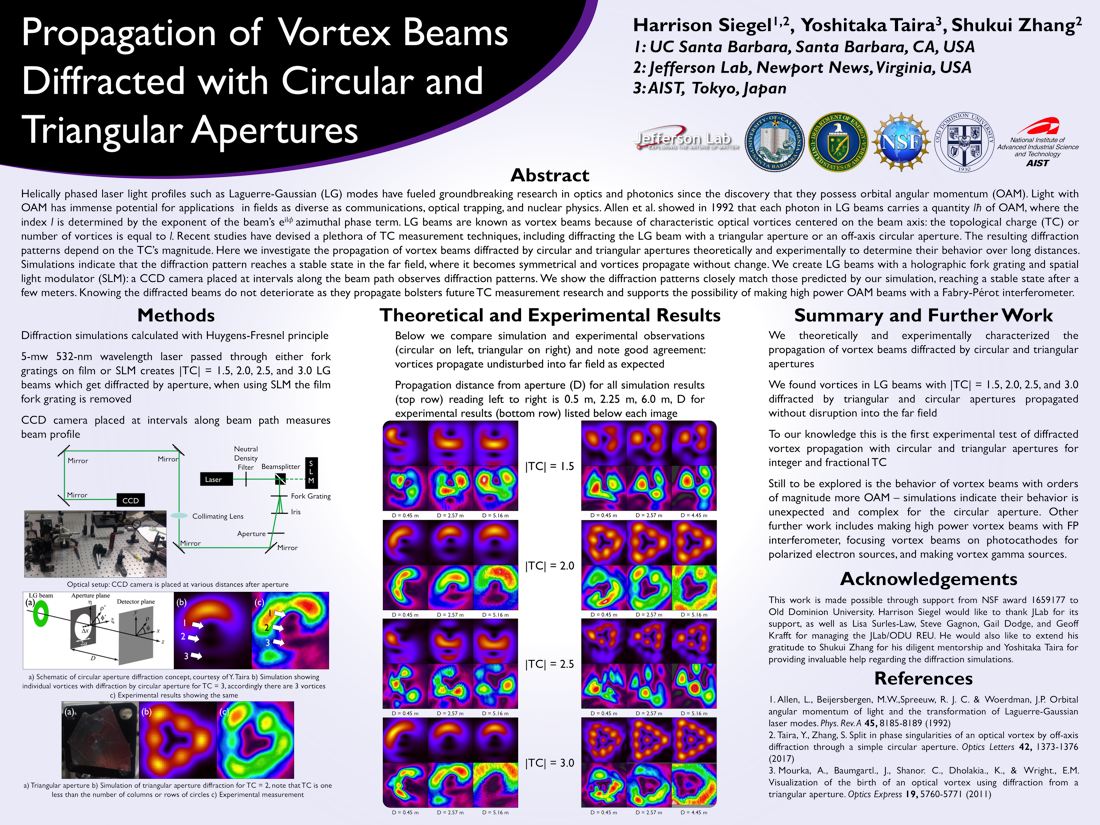Undergraduate Research at Jefferson Lab
Propagation of Vortex Beams Diffracted with Circular and Triangular Apertures
Student: Harrison Siegel
School: UC Santa Barbara
Mentored By: Shukui Zhang
Lasers have been at the forefront of cutting-edge scientific discoveries and industrial advancements for the past half century thanks in large part to their incredible precision and versatility. The light beams produced by lasers are generally well collimated, highly coherent, and of high spectral purity. The transverse intensity profile of laser beams often follows a Gaussian distribution, but any arbitrary beam satisfying the paraxial Helmholtz equation can be decomposed as a superposition of Hermite-Gaussian (HG) or Laguerre-Gaussian (LG) modes. In the last few decades helically phased beams such as HG and LG beams have attracted significant attention following the realization that they possess orbital angular momentum (OAM). Each photon in these beams carries a quantity lħ of OAM, where the index l is determined by the exponent of the beam's eilØ azimuthal phase term. LG beams with OAM have characteristic optical vortices centered on the beam axis: the topological charge (TC) or number of vortices is equal to l, and recent studies have shown that the vortices can be counted individually by diffracting the LG beam with an off-axis circular aperture. We investigate the propagation of vortices diffracted by a circular aperture both theoretically and experimentally to determine their behavior over long distances. Simulations indicate that the diffraction pattern reaches a stable state in the far field, where it becomes symmetrical and the vortices propagate undisturbed. We use a 5-mw 532-nm wavelength laser passed through a holographic fork grating to produce an LG beam and a CCD camera positioned at intervals along the beam path to observe the diffraction patterns. We show that the diffraction patterns closely match those predicted by our simulation for fractional and integer TC, reaching a stable state after a few meters. It has been established previously that LG modes are highly stable over distances as great as 143 kilometers, but to our knowledge this is the first experimental test of diffracted vortex propagation with a circular aperture. Previous studies have also looked at various types of diffraction patterns in the far field and found they matched simulations, but did not examine the diffraction patterns at different propagation distances. Knowing that the diffracted beams do not deteriorate as they propagate is useful for future research regarding TC measurement and supports the possibility of producing high power OAM beams with a Fabry-Pérot optical cavity.

Citation and linking information
For questions about this page, please contact Education Web Administrator.
